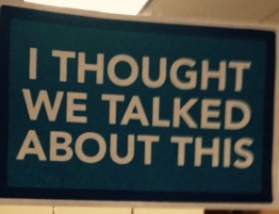
Survival Guide for the Marketer in the Next Millennium
June 30, 2014
Social Media Discovery Survey
June 30, 2014The Four Obsessions of an Extraordinary Executive
A leadership Fable
By Patrick Lencioni
The following are excerpts:
Introduction
I believe that all successful organizations share two qualities: They are smart, and they are healthy. An organization demonstrates that it is smart by developing intelligent strategies, marketing plans, product features, and financial models that lead to competitive advantage over its rivals. It demonstrates that it is healthy by eliminating politics and confusion, which leads to higher morale, lower turnover, and higher productivity. (page xiv)
The Four Disciplines of a Healthy Organization
Discipline One:
BUILD AND MAINTAIN A COHESIVE LEADERSHIP TEAM
Building a cohesive leadership team is the most critical of the four disciplines because it enables the other three. It is also the most elusive because it requires considerable interpersonal commitment from an executive team and its leader.
What Does a Cohesive Leadership Team Look Like?
More than anything else, cohesive teams are efficient. They arrive at decisions more quickly and with greater buy-in than non-cohesive teams do. They also spend less time worrying about whether their peers will commit to a plan and deliver. (page 144)
For cohesive teams, meetings are compelling and vital. They are forums for asking difficult questions, challenging one another’s ideas, and ultimately arriving at decisions that everyone agrees to support and adhere to, in the best interest of the company. (page 144)
Within the cohesive teams that I work with, members hold their peers accountable for behaviors that re not conducive to team performance. …. Everyone is involved and awake. (page 144-145)
Finally, cohesive teams fight. But they fight about issues, not personalities. Most important, when they are done fighting, they have an amazing capacity to move on to the next issue, with no residual feelings. (page 145)
How Do You Assess Your Team for Cohesiveness?
- Are meetings compelling? Are the important issues being discussed during meetings?
- Do team members engage in unguarded debate? Do they honestly confront one another?
- Do team members apologize if they get out of line? Do they ever get out of line?
- Do team members understand one another?
- Do team members avoid gossiping about one another?
(pages 149-150)
Discipline Two:
CREATE ORGANIZATIONAL CLARITY
Organizational clarity is not merely about choosing the right words to describe a company’s mission, strategy, or values; it is about agreeing on the fundamental concepts that drive it. (page 151)
What Does Organizational Clarity Look Like?
An organization that has achieved clarity has a sense of unity around everything it does. It aligns its resources, especially the human ones, around common concepts, values, definitions, goals, and strategies, thereby realizing the synergies that all great companies must achieve. (page 153)
The result is an undeniable sense of focus and efficiency (focus and edit). (page 153)
Employees in these organizations seem to have amazing levels of autonomy. They know what their boundaries are and when they need guidance from management before taking action. (page 153)
How Does an Organization Go About Achieving Clarity?
- Why does the organization exist, and what difference does it make in the world?
- What behavioral values are irreplaceable and fundamental?
- What business are we in, and against whom do we compete?
- How does our approach differ from that of our competition?
- What are our goals this month, this quarter, this year, next year, five years from now?
- Who has to do what for us to achieve our goals this month, this quarter, this year, next year, five years from now?
(pages 154-155)
Here, in summary, are the levels of goals that healthy organizations must embrace: (page 163)
- Thematic goals: What is this period’s focus?
- Major strategic goals: What are the key areas which relate to that focus, and exactly what needs to be achieved?
- Metrics: What are the ongoing measures that allow the organization to keep score?
Discipline Three
OVER-COMMUNICATE ORGANIZATIONAL CLARITY
What Does Over-Communication Look Like?
Within companies that effectively over-communicate, employees at all levels and in all departments understand what the organization is about and how they contribute to its success. They don’t spend time speculating on what executives are really thinking, and they don’t look for hidden messages amount the information they reserve. (page 166)
Employees in healthy organizations may joke, or sometimes even complain, about the volume and repetition of information that they receive. (page 166)
How Does an Executive Team Effectively Over-Communicate?
Repetition. The issue here has to do with the fear of repetition. Most executives I work with don’t like to repeat the same message again and again over time. (page 168)
Effective communication requires repetition in order to take hold in an organization. Some experts say that only after hearing a message six times does a person begin to believe and internalize it. (page 168)
Simple Messages. Another key to effective communication is the ability to avoid overcomplicating key messages. Years of education and training make most leaders feel compelled to use all of their intellectual capabilities when speaking or writing. (page 169)
Multiple Mediums. All too often, executives feel comfortable using just one form of communication to convey messages to the rest of the organization. Some leaders prefer live communication, either to large groups or in more intimate settings. (page 170)
How Do You Assess Your Organization for Effective Over-Communication?
Ask employees if they know why the organization exists, what its fundamental values are, what business it is in, whom its competitors are, what its strategy is, what the major goals for the year are, and who is responsible for doing what at the executive level. (page 173)
Discipline Four:
REINFORCE ORGANIZATIONAL CLARITY THROUGH HUMAN SYSTEMS
Hiring Profiles. Healthy organizations look for qualities in job candidates that match the values of the company. They ask behavioral questions of interviewees and probe for evidence that the candidate has the potential to fit within the organization. (page 175)
Performance Management. Another system that serves to reinforce an organization’s clarity is its performance management process. …. It serves to help employees identify their opportunities for growth and development, and to constantly realign their work and their behaviors around the direction and values of the organization at large. (pages 175-176)
The best performance management systems include only essential information, and allow managers and their employees to focus on the work that must be done to ensure success. (page 176)
Rewards and Recognition. This system has to do with the manner in which organizations reinforce behavior. Healthy organizations eliminate as much subjectivity and capriciousness as possible from the reward process by using consistent criteria for paying, recognizing, and promoting employees. (page 177)
How Does an Organization Assess Itself for Human Systems?
- Is there a process for interviewing candidates and debriefing those interviews as a team?
- Are there consistent behavioral interview questions that are asked across every department?
- Is there a consistent process for managing the performance of employees across the organization?
- Do we spend time evaluating employees’ behavior versus the organization’s values and goals?
- Do managers and employees willingly participate in the system?
- Is there a consistent process for evaluating promotion candidates against organizational values?
- Are there consistent criteria for removing employees from the organization?
- Are employees ever terminated because they are a poor fit within the organization’s values?
(pages 178-179)




